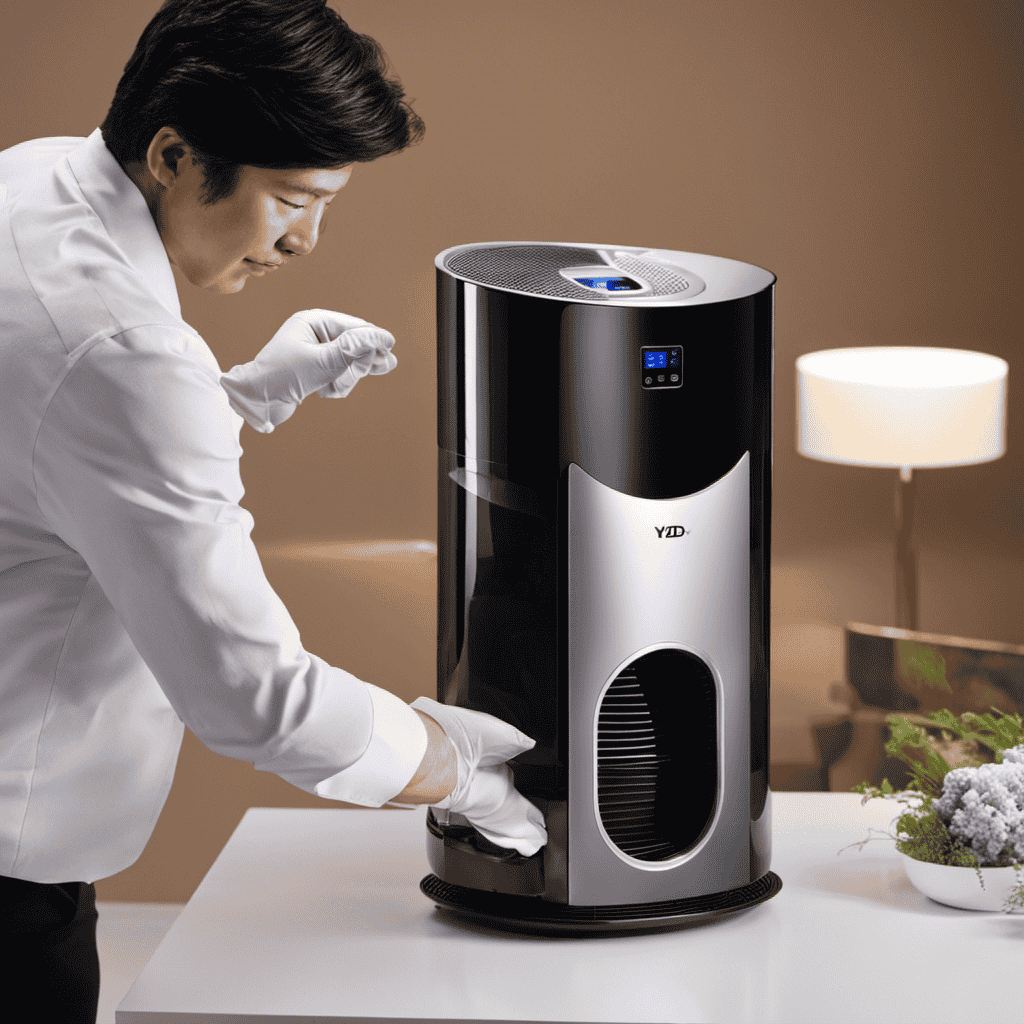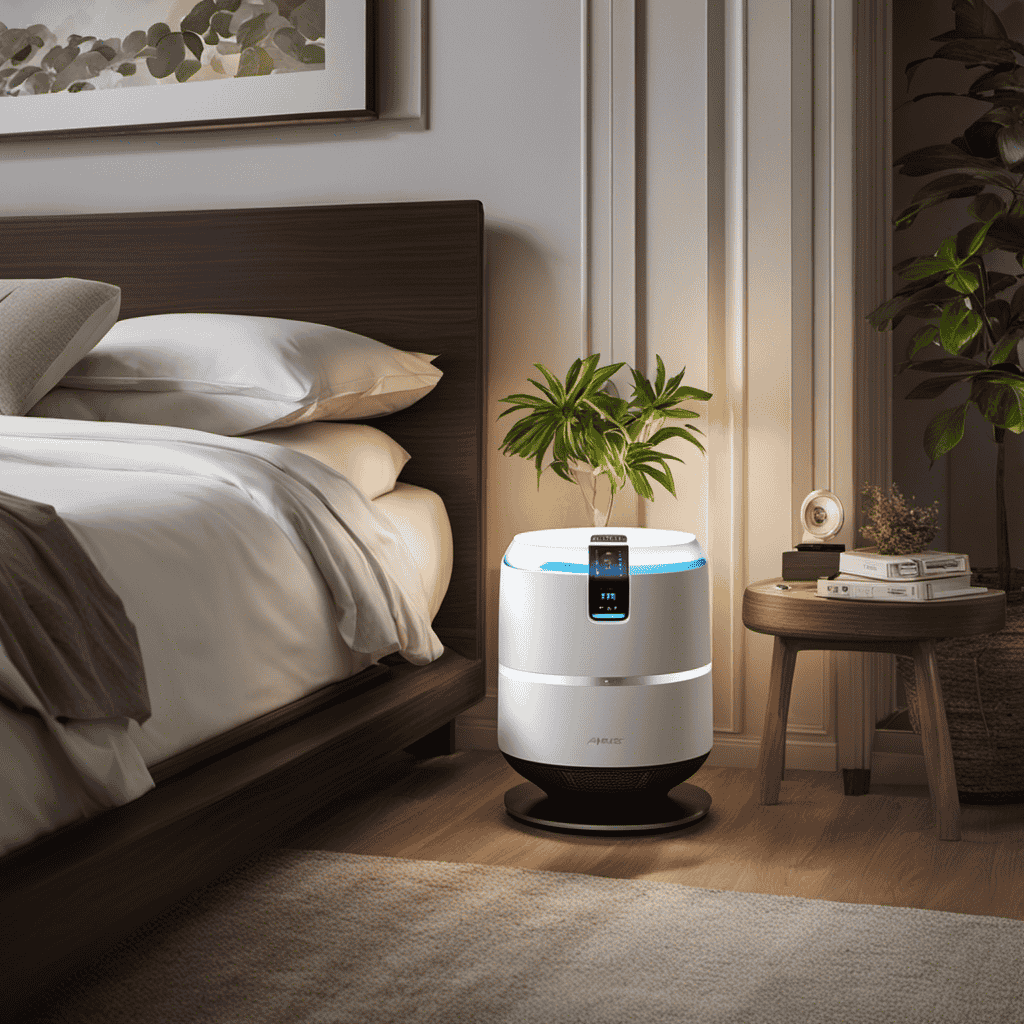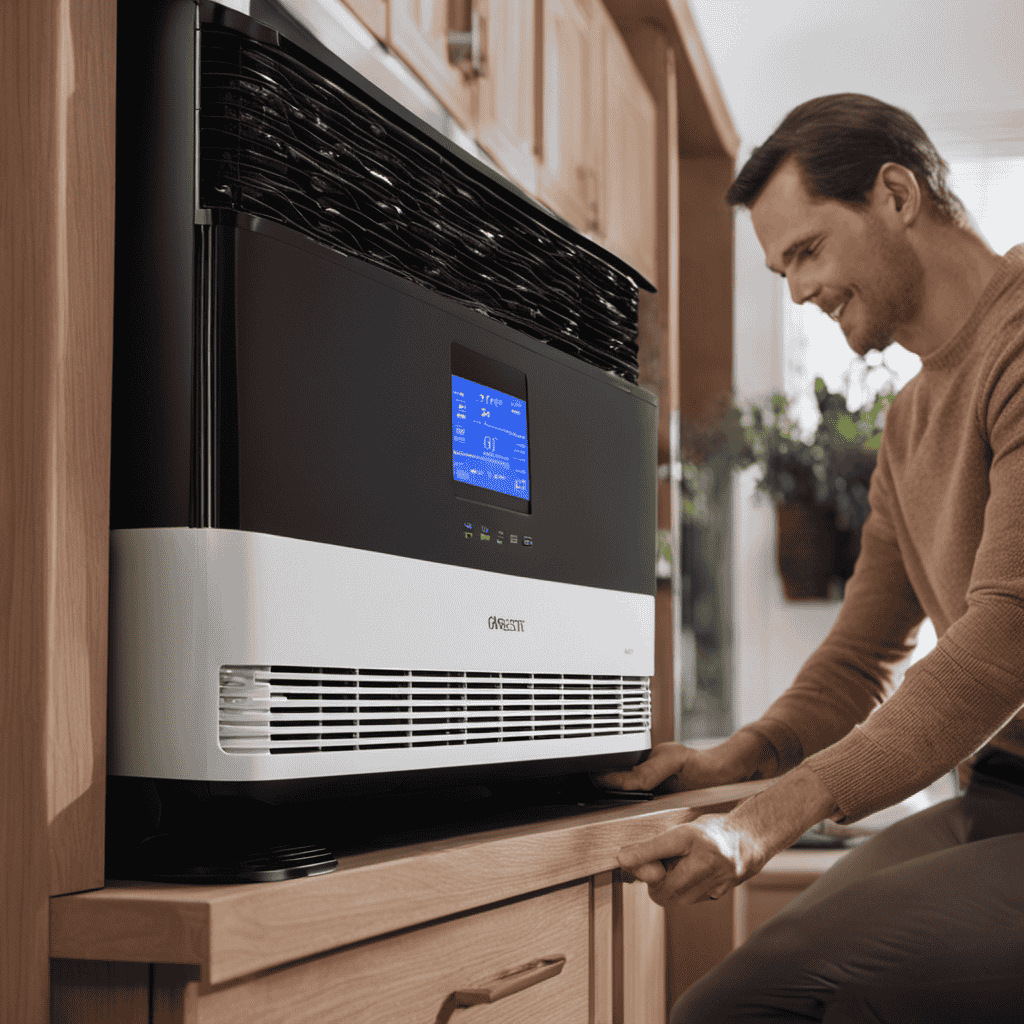Have you ever pondered why an air purifier might lead to eye dryness? In this article, I’m set to delve into the typical reasons behind dry eyes and how dry air impacts them.
We will also delve into the factors that can increase eye dryness and the role air purifiers play in exacerbating this condition.
Additionally, I will provide useful tips for combatting eye dryness with the help of an air purifier and guide you in choosing the right one for your eye health.
Let’s dive in and find some answers!
Key Takeaways
- Air purifiers can remove moisture from the air, leading to dry and irritated eyes.
- Dry air and particulate matter in the air can cause eye irritation.
- Using eye drops or artificial tears can provide temporary relief for dry eyes caused by air purifiers.
- It is important to find a balance between clean air and maintaining optimal moisture levels to ensure comfort and visual well-being.
Common Causes of Eye Dryness
One common cause of eye dryness is not blinking enough when using electronic devices. When we use devices like smartphones, tablets, or computers, we tend to stare at the screen without blinking as often as we should. Blinking helps to distribute tears across the surface of the eye, keeping it moist and preventing dryness. When we don’t blink enough, tears evaporate, leading to dry eyes.
Other causes of dry eyes include environmental factors like dry air, wind, or exposure to smoke. Certain medications, aging, and underlying health conditions can also contribute to eye dryness.
To alleviate dry eyes, it is important to take regular breaks from electronic devices, blink consciously, use artificial tears, and keep the environment humid.
How Air Purifiers Work
Air purifiers work by filtering out particles in the air, improving overall air quality. They are designed to remove various pollutants such as dust, pollen, pet dander, and smoke from the indoor environment.
The effectiveness of an air purifier in reducing indoor air pollution depends on several factors:
- Filter type: High-efficiency particulate air (HEPA) filters are considered the most effective in trapping particles as small as 0.3 microns.
- Air exchange rate: A higher air exchange rate means the air in the room is being filtered more frequently, resulting in better air quality.
- Room size: The purifier’s capacity should match the room size for optimal performance.
By effectively capturing and removing airborne pollutants, air purifiers can significantly reduce indoor air pollution.
This transition into the subsequent section about the effects of dry air on eyes can further highlight the importance of air purification in maintaining overall eye health.
Effects of Dry Air on Eyes
The effects of dry air on the eyes can be alleviated by using a humidifier in the room. When the air is dry, it can cause irritation, redness, and a feeling of dryness in the eyes. This is especially true for people who suffer from dry eye syndrome or other eye conditions.
Dry air can also worsen the symptoms of eye allergies and exacerbate the effects of air pollution on the eyes. Using a humidifier in the room can help to increase the moisture levels in the air, reducing the dryness and discomfort in the eyes.
Additionally, using eye drops can provide immediate relief by lubricating the eyes and reducing dryness. Eye drops can also help to flush out any irritants or pollutants that may have entered the eyes, providing further protection against the effects of air pollution.
Factors That Increase Eye Dryness
Using a humidifier can help alleviate dryness and discomfort in the eyes. It increases moisture levels in the room, providing relief. Factors that contribute to eye dryness include environmental conditions, such as low humidity levels and exposure to dry air for extended periods. Excessive screen time, aging, certain medical conditions like Sjögren’s syndrome, and the use of contact lenses also play a role. Symptoms of dry eyes can vary but commonly include redness, itching, a gritty sensation, and blurry vision. It’s important to address these factors to prevent and manage dry eyes effectively.
Transition: Now that we have discussed the factors affecting eye dryness, let’s explore the role of air purifiers in contributing to this issue.
The Role of Air Purifiers in Eye Dryness
Air purifiers are commonly used to improve indoor air quality by removing pollutants and allergens from the air. However, some individuals may experience eye discomfort when using an air purifier.
This discomfort can be attributed to the decrease in moisture levels caused by the purifier, leading to dry and irritated eyes.
Air Purifier Eye Discomfort
Feeling discomfort in your eyes? An air purifier might be causing it. When using an air purifier, it is important to consider its potential effects on eye health. Here are a few reasons why an air purifier may lead to eye discomfort:
-
Dry air: Air purifiers remove moisture from the air, resulting in drier indoor environments. This lack of humidity can cause dryness and irritation in the eyes.
-
Particulate matter: Air purifiers capture airborne particles, including dust, pollen, and pet dander. These particles can irritate the eyes and trigger dryness.
-
Solution: Consider using eye drops or artificial tears to lubricate and hydrate the eyes. These products can provide temporary relief from dryness caused by air purifiers.
Understanding the potential impact of air purifiers on eye health is essential for maintaining comfort and visual well-being. By taking appropriate measures, such as using eye drops, individuals can alleviate discomfort and ensure a pleasant indoor environment.
Moisture Levels and Purifiers
To prevent discomfort in your eyes, it’s important to be aware of how moisture levels can be affected by air purifiers.
Air purifiers are designed to improve air quality by removing pollutants and allergens. However, some models can also reduce the moisture content in the air, leading to dryness and irritation in the eyes.
This happens because air purifiers often circulate the air, which can result in the removal of humidity. When the air becomes too dry, it can cause dry eyes, itchiness, and a burning sensation.
It’s crucial to find a balance between clean air and maintaining adequate moisture levels.
In the next section, I will provide some tips for combating eye dryness with an air purifier.
Tips for Combating Eye Dryness With an Air Purifier
Using an air purifier can help alleviate eye dryness by increasing the humidity in the room. Here are some tips for combating eye dryness with an air purifier:
-
Regularly clean and maintain your air purifier:
-
Clean the filters according to the manufacturer’s instructions to ensure proper functioning.
-
Replace filters when necessary to prevent accumulation of dust and allergens.
-
Use a humidifier in conjunction with your air purifier:
-
Adding moisture to the air can help prevent dryness and irritation in your eyes.
-
Place the humidifier near the air purifier to distribute moisture evenly throughout the room.
Choosing the Right Air Purifier for Eye Health
When it comes to choosing the right air purifier for eye health, there are several key points to consider.
First, it’s important to take into account the humidity levels in your environment. Maintaining optimal humidity can help prevent dryness and irritation in the eyes.
Secondly, look for air purifiers that feature eye-friendly filtration systems, such as HEPA filters, which can effectively remove allergens, dust, and other irritants from the air.
Lastly, consider the potential irritant removal capabilities of the air purifier, as reducing exposure to common irritants like pet dander, pollen, and smoke can greatly benefit eye health.
Humidity Level Considerations
The air purifier could be causing dry eyes due to low humidity levels in the room. When the air purifier is turned on, it filters out contaminants and particles from the air, which improves indoor air quality. However, it can also remove moisture from the air, leading to dryness in the eyes.
Here are some important considerations regarding humidity levels and indoor air quality:
-
Humidity control:
-
Maintaining an optimal humidity level between 40% to 60% can help prevent dry eyes.
-
Using a humidifier can help increase humidity levels in the room, counteracting the drying effects of the air purifier.
-
Indoor air quality:
-
An air purifier is an effective tool for removing allergens, dust, and pollutants from the air, improving overall indoor air quality.
-
However, it is important to balance the use of the air purifier with proper humidity control to avoid dryness and discomfort in the eyes.
Eye-Friendly Filtration Systems
To prevent dry eyes, you can consider eye-friendly filtration systems that maintain optimal humidity levels in the room. These filters are designed to remove impurities from the air while also preventing the air from becoming too dry.
Eye-friendly filters typically incorporate features such as humidifiers or moisture control systems to ensure that the air remains at a comfortable humidity level. By using these filters, you can help prevent eye discomfort caused by dryness, which can include symptoms such as itching, redness, and irritation.
However, it’s important to note that eye-friendly filters primarily focus on maintaining humidity levels and may not necessarily address other potential irritants in the air.
In the next section, we will explore how air purifiers can help remove potential irritants and improve air quality.
Potential Irritant Removal
Consider using eye-friendly filtration systems that incorporate features to remove potential irritants from the air, such as allergens, dust, and pet dander. These filtration systems have the potential to provide several benefits for individuals with sensitive eyes.
Some potential benefits include:
-
Reduction of allergens: Eye-friendly filtration systems are designed to capture and remove allergens from the air, which can help reduce the risk of allergic reactions and alleviate symptoms such as itchy and dry eyes.
-
Dust removal: By removing dust particles from the air, these filtration systems can help prevent dust from settling on surfaces, reducing the need for frequent cleaning and minimizing eye irritation caused by dust.
-
Pet dander elimination: Individuals with pets may experience eye irritation due to pet dander. Eye-friendly filtration systems can effectively filter out pet dander, helping to alleviate discomfort and improve overall eye health.
Other Solutions for Eye Dryness
Try using eye drops to alleviate your dryness instead of relying solely on an air purifier. When wearing contact lenses, it is common to experience dryness due to increased evaporation of tears.
Air purifiers may help remove irritants from the air, but they can also contribute to dryness by reducing humidity levels.
Artificial tears, on the other hand, provide lubrication and moisture to the eyes, relieving discomfort caused by dryness. These eye drops mimic the natural tears and can be used while wearing contact lenses. They come in different formulations, including preservative-free options, and can be easily found over-the-counter.
It is important to follow the instructions provided by the manufacturer and consult with an eye care professional if dryness persists or worsens.
Frequently Asked Questions
Can Using an Air Purifier Cause Any Long-Term Damage to My Eyes?
Using an air purifier can cause eye irritation, but it’s unlikely to cause long-term damage. To prevent dry eyes, ensure proper humidity levels, keep the purifier at a safe distance, and take regular breaks to rest your eyes.
Are There Any Specific Air Purifier Models or Brands That Are Known to Cause More Eye Dryness?
Specific air purifier models can cause excessive eye dryness. It’s essential to research brands with adequate moisture control features to avoid discomfort. Taking necessary eye dryness precautions will ensure a better air purifier experience.
Can Using an Air Purifier Worsen Existing Eye Conditions, Such as Dry Eye Syndrome?
Using an air purifier can worsen existing eye conditions like dry eye syndrome due to the removal of moisture from the air. To prevent this, ensure proper air purifier maintenance, such as regular filter cleaning and maintaining appropriate humidity levels.
Are There Any Specific Times of the Year When Using an Air Purifier Might Lead to More Eye Dryness?
During certain times of the year, using certain air purifier models can lead to increased eye dryness. It’s important to consider factors like humidity levels and the type of air purifier being used.
Is There a Recommended Duration for Using an Air Purifier to Minimize Eye Dryness?
There isn’t a specific recommended duration for using an air purifier to minimize eye dryness. However, it’s important to ensure proper humidity levels and take breaks from prolonged exposure to reduce any potential discomfort.
Conclusion
In conclusion, the journey of understanding why an air purifier can cause dry eyes has been like navigating through a dense forest.
Just like how an air purifier filters out impurities from the air, it also strips away the moisture that our eyes need to stay hydrated.
Symbolically, it serves as a reminder that balance is key in every aspect of life, even in the pursuit of clean air.
By choosing the right air purifier and implementing other solutions, we can find harmony between clean air and healthy, moisturized eyes.










